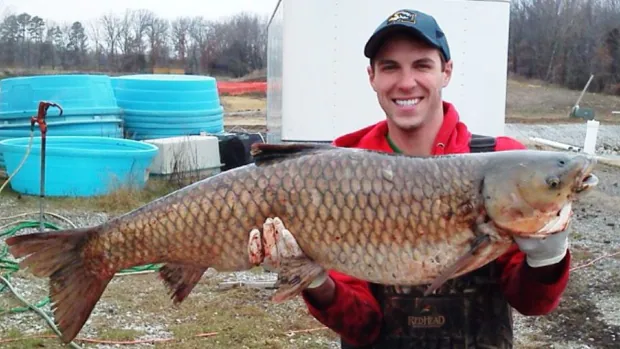You are within the temper for fish and your server suggests a dish of invasive carp. ‘Ugh,’ you may say. However how about broiled copi, recent from the Mississippi River?
This is the catch: They’re the identical factor.
Illinois and associate organizations within the U.S. kicked off a market-tested marketing campaign Wednesday to rechristen as “copi” 4 species beforehand recognized collectively as Asian carp, hoping the brand new label will make them extra enticing to U.S. shoppers.
Turning carp into a preferred family and restaurant menu merchandise is a method officers hope to rein in a decades-old invasion threatening native fish, mussels and aquatic crops within the Mississippi and different Midwestern rivers, in addition to the Nice Lakes.
“The ‘carp’ title is so harsh that individuals will not even strive it,” mentioned Kevin Irons, assistant fisheries chief with the Illinois Division of Pure Assets. “Nevertheless it’s wholesome, clear and it actually tastes fairly darn good.”
The federal Nice Lakes Restoration Initiative is funding the five-year, $600,000 mission to rebrand the carp and make them broadly obtainable. Greater than two dozen distributors, processors, eating places and retailers have signed on. Most are in Illinois, however some ship to a number of states or nationwide.
“This could possibly be an incredible breakthrough,” mentioned John Goss, who led the Obama administration’s effort to halt the carp invasion and labored on the renaming mission. “The subsequent couple of years are very crucial for constructing confidence and acceptance.”
It has a pleasant, delicate taste … a nice shock that ought to assist repair its fame,Brian Jupiter, chef in Chicago
Span, a Chicago communications design firm, got here up with “copi.” It is an abbreviated wordplay on “copious” — a reference to the booming populations of bighead, silver, grass and black carp within the U.S. heartland.
Imported from Asia within the Sixties-70s to gobble algae from Deep South sewage lagoons and fish farms, they escaped into the Mississippi. They’ve infested many of the river and plenty of tributaries, crowding out native species like bass and crappie.
Regulators have spent greater than $600 million to maintain them from the Nice Lakes and waters comparable to Lake Barkley on the Kentucky-Tennessee line. Methods embody inserting electrical boundaries at choke factors and hiring crews to reap the fish for merchandise comparable to fertilizer and pet meals. Different applied sciences — underwater noisemakers, air bubble curtains — are within the works.
It might assist if extra folks ate the critters, that are fashionable in different international locations. Officers estimate as much as 22.7 million kilograms could possibly be netted yearly within the Illinois River between the Mississippi and Lake Michigan. Much more can be found from the Midwest to the Gulf Coast.
“Authorities subsidies alone won’t finish this battle,” Goss mentioned. “Non-public-sector, market-driven demand for copi could possibly be our greatest hope.”
Copi po’boy? Fish has ‘delicate’ flavour
Within the U.S. and Canada, carp are recognized primarily as muddy-tasting backside feeders. Bighead and silver carp, the first targets of the “copi” marketing campaign, dwell greater within the water column, feeding on algae and plankton. Grass carp eat aquatic crops, whereas black carp choose mussels and snails. All 4 are excessive in omega-3 fatty acids and low in mercury and different contaminants, Irons mentioned.
“It has a pleasant, delicate taste … a nice shock that ought to assist repair its fame,” mentioned Brian Jupiter, a Chicago chef who plans to supply a copi po’boy sandwich at his Ina Mae Tavern. The fish is adaptable to quite a few cuisines together with Cajun, Asian and Latin, he mentioned.

But it could possibly be a tough promote, significantly as a result of the fish’s infamous boniness makes it difficult to provide fillets many diners anticipate, Jupiter added. A few of the greatest recipes could use chopped or floor copi, he mentioned.
Dirk and Terry Fucik, homeowners of Dirk’s Fish and Connoisseur Store in Chicago, mentioned they’ve bought carp burgers for years and provide carp meatballs, tacos and different dishes.
Span researchers thought-about many names — “butterfin” amongst them — earlier than deciding on “copi,” Irons mentioned. It sounded catchy, a tad unique, even enjoyable, he mentioned.
Span performed surveys, interviews and focus group conferences with greater than 350 Illinois residents, design principal Nick Adam mentioned.
Subsequent step: Looking for approval from the federal Meals and Drug Administration, which says “coined or fanciful” fish labels can be utilized if not deceptive or complicated. A well-known instance is “slimehead,” which grew to become a success after its market moniker was switched to “orange roughy.”

Illinois additionally plans to register the “copi” trademark, enabling business teams to develop high quality management procedures, Irons mentioned.
Different regulatory businesses and scientific teams have their very own insurance policies and may not make the swap.
The American Society of Ichthyologists and Herpetologists and the American Fisheries Society have a committee that lists fish titles, together with scientific names in Latin and long-accepted frequent names. The panel by no means adopted “Asian carp” as an umbrella time period for the invasive species.
The U.S. Fish and Wildlife Service plans to stay with “invasive carp” and the 4 particular person names, as its focus is on managing and controlling their unfold, mentioned Charlie Wooley, Midwest director. The Invasive Carp Regional Coordinating Committee, which includes quite a few federal, state, native and Canadian provincial businesses, will do likewise.
They dropped “Asian carp” final 12 months due to concern about anti-Asian bigotry.

